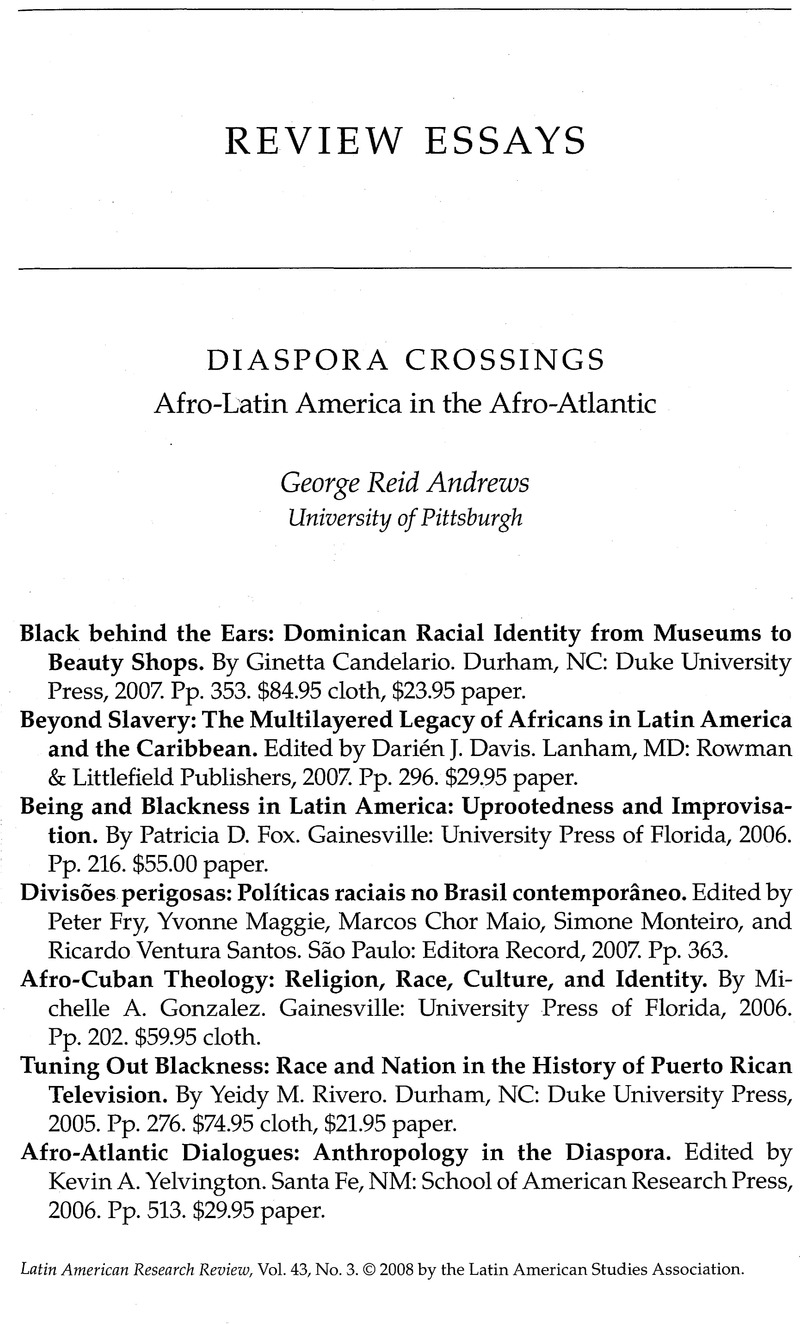No CrossRef data available.
Published online by Cambridge University Press: 05 September 2022

1. Kwame Dixon, “Beyond Race and Gender: Recent Works on Afro-Latin America,” Latin American Research Review 41, no. 3 (2006): 247.
2. For additional bibliography and surveys of recent scholarship, see Herbert Klein and Ben Vinson III, African Slavery in Latin America and the Caribbean (New York: Oxford University Press, 2007); Laird Bergad, The Comparative Histories of Slavery in Brazil, Cuba, and the United States (New York: Cambridge University Press, 2007); Marcus Rediker, The Slave Ship: A Human History (New York: Viking/Penguin, 2007); George Reid Andrews, Afro-Latin America, 1800–2000 (New York: Oxford University Press, 2004).
3. Eduardo Silva, As camélias do Leblon e a abolição da escravatura (São Paulo: Companhia das Letras, 2003); Aline Helg, Our Rightful Share: The Afro-Cuban Struggle for Equality, 1886–1912 (Chapel Hill: University of North Carolina Press, 1995).
4. Melville Herskovits, The Myth of the Negro Past (New York: Harper and Brothers, 1941).
5. In a darker section of the essay, Yelvington also shows how Herskovits used his gatekeeping power over grants and hiring to discourage other anthropologists from encroaching on his turf. Yelvington cites the cases of Ruth Landes and several African American anthropologists who, Herskovits felt, lacked the necessary objectivity to do research on these topics (67–76).
6. E. Franklin Frazier, The Negro Family in the United States (Chicago: University of Chicago Press, 1939).
7. Sidney Mintz and Richard Price, An Anthropological Approach to the Afro-American Past: A Caribbean Perspective (Philadelphia: Institute for the Study of Human Issues, 1976), and The Birth of African-American Culture: An Anthropological Approach, 2d ed. (Boston: Beacon Press, 1992).
8. Robert Farris Thompson, Flash of the Spirit: African and Afro-American Art and Philosophy (New York: Random House, 1983); Michael A. Gomez, Exchanging Our Country Marks: The Transformation of African Identities in the Colonial and Antebellum South (Chapel Hill: University of North Carolina Press, 1998); John Thornton, Africa and Africans in the Making of the Atlantic World, 1400–1800 (Cambridge: Cambridge University Press, 1998).
9. J. Lorand Matory, Black Atlantic Religion: Tradition, Transnationalism, and Matriarchy in the Brazilian Candomblé (Princeton, NJ: Princeton University Press, 2005).
10. A good start would be David H. Brown, Santería Enthroned: Art, Ritual, and Innovation in an Afro-Cuban Religion (Chicago: University of Chicago Press, 2003).
11. According to Candelario, the number of Dominicans identifying as black fell dramatically, from 25 percent in 1990 to 9 percent in 2000 (20, 23). She offers no explanation for this decline; might it have been caused by the U.S. government's retreat from affirmative action during those years, combined with continued immigration from the Dominican Republic?
12. Yeidy Rivero presents similar findings for Puerto Rico. On the concept of jincha (too pale, too white), see Tuning Out Blackness, 125.
13. Jill Lane, Blackface Cuba, 1840–1895 (Philadelphia: University of Pennsylvania Press, 2005).
14. Rivero is slightly unclear on this point. She refers to the disappearance of blackface performers in the 1980s (104) but later mentions blackface television characters in the 1990s (150, 156).
15. Mala Htun, “From ‘Racial Democracy’ to Affirmative Action: Changing State Policy on Race in Brazil,” Latin American Research Review 39, no. 1 (2004): 60–89.
16. The bill was never voted on and, as of February 2008, was still being reviewed in committee.
17. For an overview and an important addition to that literature, see Edward Telles, Race in Another America: The Significance of Skin Color in Brazil (Princeton, NJ: Princeton University Press, 2004).
18. Strong support for this argument can be found in Cuba, where, during the 1960s and 1970s, state provision of health care, education, and employment opportunities to workers and peasants came very close to eliminating class and racial inequalities. Alejandro de la Fuente, A Nation for All: Race, Inequality and Politics in Twentieth-Century Cuba, 259–316 (Chapel Hill: University of North Carolina Press, 2001).
19. For the 2006 version of the bill, see http://www.senado.gov.br/paulopaim/pages/vida/publicacoes/textos/Estatuto_da_Igualdade_Racial_Novo.pdf (accessed February 5, 2008).
20. Some representative titles are Roger Bastide and Florestan Fernandes, Brancos e negros em São Paulo, 3d ed. (São Paulo: Editora Nacional, 1971); Florestan Fernandes, O negro no mundo dos brancos (São Paulo: Difusão Européia do Livro, 1972); Maria Suely Kofes de Almeida, “Entre nós, os pobres, eles, os negros” (master's thesis, Universidade Estadual de Campinas, 1972); Haroldo Costa, Fala, crioulo (Rio de Janeiro: Editora Record, 1982); George Reid Andrews, Blacks and Whites in São Paulo, Brazil, 1888–1988 (Madison: University of Wisconsin Press, 1991); Michael Hanchard, Orpheus and Power: The Movimento Negro in Rio de Janeiro and São Paulo, Brazil, 1945–1988 (Princeton, NJ: Princeton University Press, 1994); Antonio Sérgio Alfredo Guimarães, Racismo e anti-racismo no Brasil (São Paulo: Editora 34, 1999); Antonio Sérgio Alfredo Guimarães and Lynn Huntley, eds., Tirando a máscara: Ensaios sobre o racismo no Brasil (São Paulo: Editora Paz e Terra, 2000); Robin E. Sheriff, Dreaming Equality: Color, Race, and Racism in Urban Brazil (New Brunswick, NJ: Rutgers University Press, 2001); Telles, Race in Another America; Carlos Hasenbalg, Discriminação e desigualdades raciais no Brasil, 2d ed. (Belo Horizonte: Universidade Federal de Minas Gerais, 2005); Paulina Alberto, “Terms of Inclusion: Africa and the Politics of Belonging in 20th Century Brazil” (Ph.D. diss., University of Pennsylvania, 2005).
21. For a forceful presentation of this argument, see Telles, Race, 239–270.
22. See, e.g., William G. Bowen and Derek Bok, The Shape of the River: Long-Term Consequences of Considering Race in College and University Admissions (Princeton, NJ: Princeton University Press, 1998).